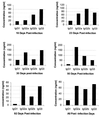Persistent Ehrlichia chaffeensis infection occurs in the absence of functional major histocompatibility complex class II genes
- PMID: 11748204
- PMCID: PMC127650
- DOI: 10.1128/IAI.70.1.380-388.2002
Persistent Ehrlichia chaffeensis infection occurs in the absence of functional major histocompatibility complex class II genes
Abstract
Human monocytic ehrlichiosis is an emerging tick-borne disease caused by the rickettsia Ehrlichia chaffeensis. We investigated the impact of two genes that control macrophage and T-cell function on murine resistance to E. chaffeensis. Congenic pairs of wild-type and toll-like receptor 4 (tlr4)- or major histocompatibility complex class II (MHC-II)-deficient mice were used for these studies. Wild-type mice cleared the infection within 2 weeks, and the response included macrophage activation and the synthesis of E. chaffeensis-specific Th1-type immunoglobulin G response. The absence of a functional tlr4 gene depressed nitric oxide and interleukin 6 secretion by macrophages and resulted in short-term persistent infections for > or =30 days. In the absence of MHC-II alleles, E. chaffeensis infections persisted throughout the entire 3-month evaluation period. Together, these data suggest that macrophage activation and cell-mediated immunity, orchestrated by CD4(+) T cells, are critical for conferring resistance to E. chaffeensis.
Figures





References
-
- Andrew, H. R., and R. A. Norval. 1989. The carrier status of sheep, cattle and African buffalo recovered from heartwater. Vet. Parasitol. 34: 261–266. - PubMed
-
- Banerjee, R., J. Anguita, D. Roos, and E. Fikrig. 2000. Cutting edge: infection by the agent of human granulocytic ehrlichiosis prevents the respiratory burst by down-regulating gp91phox. J. Immunol. 164: 3946–3949. - PubMed
Publication types
MeSH terms
Substances
Grants and funding
LinkOut - more resources
Full Text Sources
Molecular Biology Databases
Research Materials

